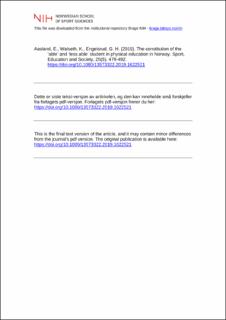| dc.contributor.author | Aasland, Erik | |
| dc.contributor.author | Walseth, Kristin | |
| dc.contributor.author | Engelsrud, Gunn Helene | |
| dc.date.accessioned | 2020-12-15T09:35:11Z | |
| dc.date.available | 2020-12-15T09:35:11Z | |
| dc.date.created | 2019-06-03T07:55:26Z | |
| dc.date.issued | 2019 | |
| dc.identifier.citation | Sport, Education and Society. 2019, 25(5), 479-492. | en_US |
| dc.identifier.issn | 1357-3322 | |
| dc.identifier.uri | https://hdl.handle.net/11250/2719448 | |
| dc.description | I Brage finner du siste tekst-versjon av artikkelen, og den kan inneholde ubetydelige forskjeller fra forlagets pdf-versjon. Forlagets pdf-versjon finner du på tandfonline.com / In Brage you'll find the final text version of the article, and it may contain insignificant differences from the journal's pdf version. The definitive version is available at tandfonline.com | en_US |
| dc.description.abstract | In recent years, the judgements that typically determine who is an ‘able’ physical education (PE) student have been sharply challenged. The research literature suggests that skills in sports, health-related fitness, toughness, competitiveness and effort typically play a significant role in assessment procedures. Although Evans (2004) lamented the paucity of research relating to ‘ability’ in PE nearly 15 years ago, little new empirical research has appeared based on studies of teaching practice. What exists relies on interview material from teachers (and students). However, few studies have investigated how the practices of teaching lessons constitute who is an ‘able’ or ‘less able’ student. Accordingly, our aim is to investigate how ‘able’ and ‘less able’ students are currently constituted in PE teaching practice. Our framework for this analysis is discourse theory, inspired by the work of Michel Foucault. The empirical material consists of observations and conversations in 92 classes, produced during fieldwork at four separate upper-secondary schools in Oslo, Norway. Our findings reveal that achieving the status of being an ‘able student’ requires attaining specific scores on physical tests, in addition to exhibiting skills in traditional ball games. This finding is valid for both boys and girls. Regarding gender performativity, being perceived as a ‘spunky girl’ results in a positive evaluation, while being timid or shy is not similarly valued. Our findings support the conclusion found in prior literature that dominant discourses in health and sport produce relatively static conceptualisations/categories regarding ‘able’ and ‘less able’ students, while student potential for learning and improvement gets short shrift. However, beneath this surface consensus, we found that the constitution of ‘able’ and ‘less able’ students is generating negotiations and tensions between official educational policy and teaching practice, as well as between teachers and students. | en_US |
| dc.language.iso | eng | en_US |
| dc.subject | teaching practice | en_US |
| dc.subject | able student | en_US |
| dc.subject | less able student | en_US |
| dc.subject | discourse | en_US |
| dc.subject | Foucault | en_US |
| dc.subject | constitution | en_US |
| dc.title | The constitution of the ‘able’ and ‘less able’ student in physical education in Norway | en_US |
| dc.type | Peer reviewed | en_US |
| dc.type | Journal article | en_US |
| dc.description.version | acceptedVersion | en_US |
| dc.source.pagenumber | 479-492 | en_US |
| dc.source.journal | Sport, Education and Society | en_US |
| dc.identifier.doi | 10.1080/13573322.2019.1622521 | |
| dc.identifier.cristin | 1702156 | |
| dc.description.localcode | Seksjon for kroppsøving og pedagogikk / Department of Physical Education | en_US |
| cristin.ispublished | true | |
| cristin.fulltext | postprint | |
| cristin.qualitycode | 2 | |
